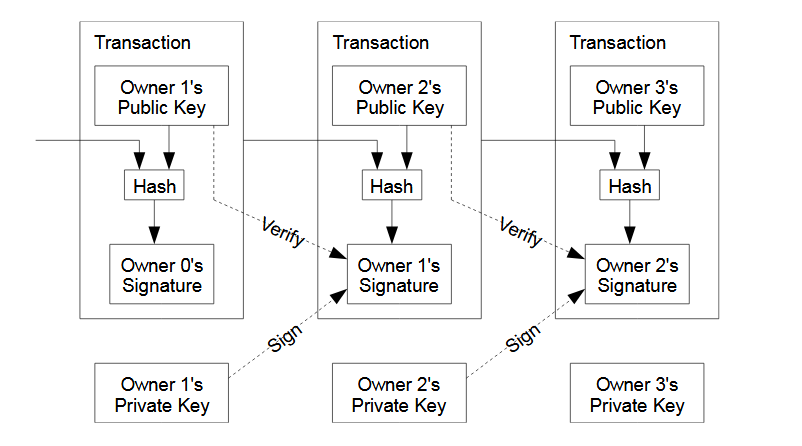Difference between revisions of "Digital signatures in Bitcoin"
m (Brendan moved page Digital Signatures in Bitcoin to Digital signatures in Bitcoin) |
|||
| (One intermediate revision by one other user not shown) | |||
| Line 1: | Line 1: | ||
| − | The | + | The Bitcoin whitepaper describes an electronic coin as a chain of digital [[signatures]]. These digital signatures confer practical control, and in most cases, ownership over the coins held in any given script, and can be used as a record of custodial control to trace transfers of control back through the history of the ledger. |
[[File:Chain_of_Signatures.png|frame|centre|alt=Electronic coins are defined as a chain of digital signatures]] | [[File:Chain_of_Signatures.png|frame|centre|alt=Electronic coins are defined as a chain of digital signatures]] | ||
| Line 16: | Line 16: | ||
==Rabin Signatures== | ==Rabin Signatures== | ||
| − | Researchers at nChain have begun developing methods of validating [https://nchain.com/app/uploads/2018/09/Rabin-Signatures-in-Bitcoin-Cash-v2.pdf Rabin signatures] in Bitcoin script. These signatures could theoretically allow for data collected outside the Bitcoin SV ledger to be evaluated and signed, allowing oracle functionality within Bitcoin transactions. | + | Researchers at nChain have begun developing methods of validating [https://nchain.com/app/uploads/2018/09/Rabin-Signatures-in-Bitcoin-Cash-v2.pdf Rabin signatures] in Bitcoin script. These signatures could theoretically allow for data collected outside the Bitcoin SV ledger to be evaluated and signed, allowing [[oracle]] functionality within Bitcoin transactions. |
Currently no practical implementation of a Rabin signature in Bitcoin Script exists. | Currently no practical implementation of a Rabin signature in Bitcoin Script exists. | ||
Latest revision as of 12:05, 5 June 2024
The Bitcoin whitepaper describes an electronic coin as a chain of digital signatures. These digital signatures confer practical control, and in most cases, ownership over the coins held in any given script, and can be used as a record of custodial control to trace transfers of control back through the history of the ledger.
A digital signature isn't merely a message signed using a given keypair, but is a link to an identity. The European Union legislation on digital signatures states that signatures correspond to “data in electronic form which are attached to or logically associated with other electronic data and which serve as a method of authentication”. For more information, see this article from Dr Craig Wright.
Bitcoin script allows users to lock/unlock their bitcoin in different ways.
Elliptical Curve Digital Signature Algorithm (ECDSA)
Elliptic Curve Digital Signature Algorithm is the most commonly used signature type in Bitcoin. It makes use of the elliptic curve cryptography keypairs referenced in Bitcoin addresses to generate secure signatures from a given message hash.
Using Bitcoin Script, it is possible to create novel systems that use elliptical curve digital signatures, including R-Puzzles, multisignature scripts and Threshold Signatures.
Threshold Signatures
There have also been practical implementations of Threshold Signatures in Bitcoin wallets and libraries, which extend Elliptic Curve signatures to enable multiple parties to participate in the creation of a signature, created from a private key that is never explicitly calculated or previously existed. When used in a transaction, a Threshold Signature is no different to a normal ECDSA signature and can be validated using OP_CHECKSIG and related signature check opcodes.
Rabin Signatures
Researchers at nChain have begun developing methods of validating Rabin signatures in Bitcoin script. These signatures could theoretically allow for data collected outside the Bitcoin SV ledger to be evaluated and signed, allowing oracle functionality within Bitcoin transactions. Currently no practical implementation of a Rabin signature in Bitcoin Script exists.
